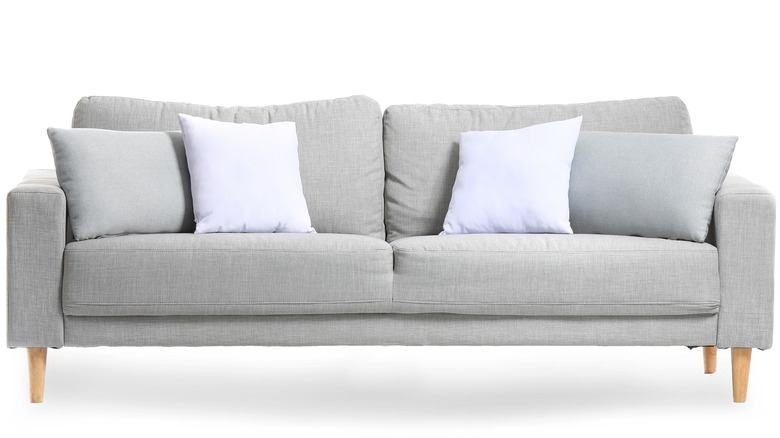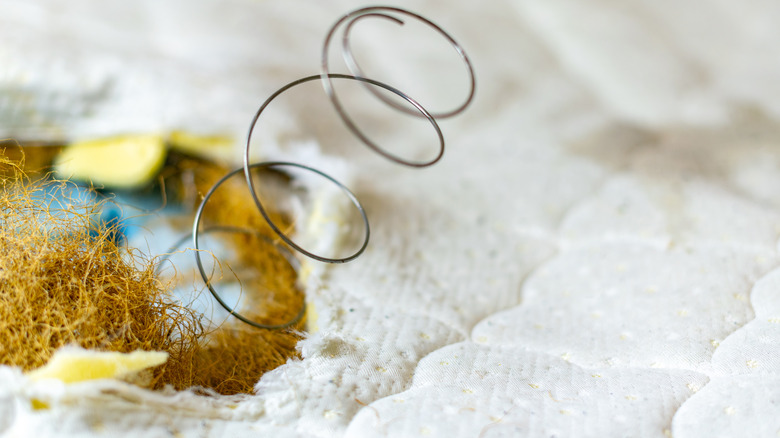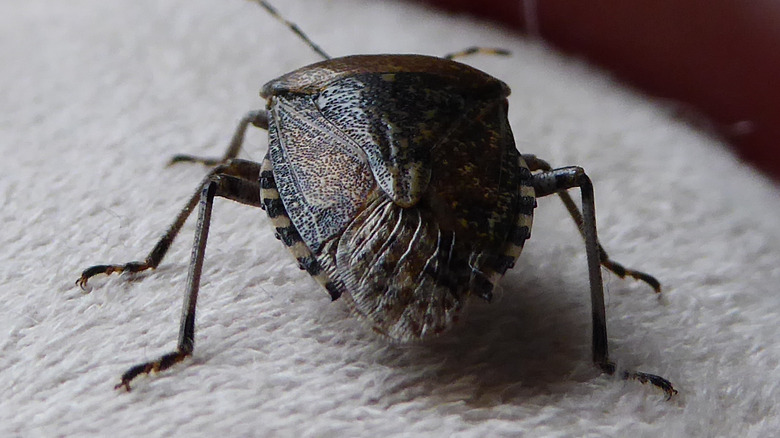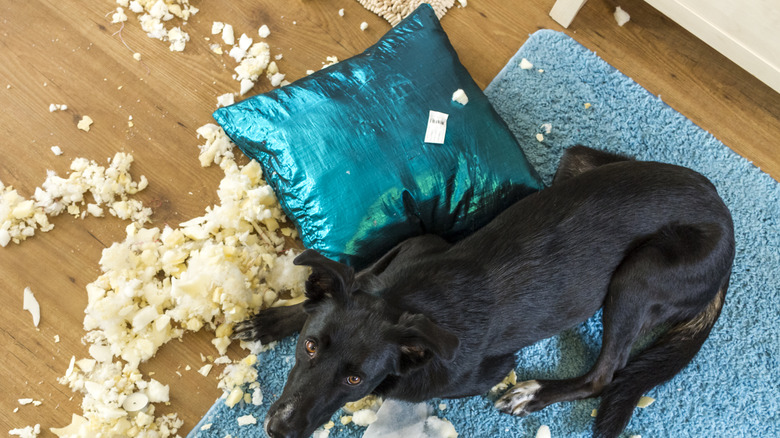Here Are The Signs Your Cushions Are Too Old
Comfort is the magic that turns a house into a home. In fact, designers on popular home renovation shows have repeatedly proven this through strategic arrangements of meticulously selected interior and exterior elements. From cozy mattresses for a pleasant night's rest to body-cradling buffers on ultra-soft sofas, cushions add a sizeable boost of comfort and warmth to sofas and chairs, according to Boo Roo and Tiger Too.
However, upholstery doesn't last forever and typically has a lifespan of three to five years (via Insider's Guide to Furniture). This largely depends on several factors, including material, design, and location. With plenty of usage over the years, indoor cushions can be sprayed with protectors to guard against stains. According to Yorkshire Fabric Shop, outdoor versions are frequently protected from excessive radiation with sun-resistant UV sprays, and both are safeguarded against mold and mildew. However, the petering-out stage is inevitable. So, when is the best time to start preparing to replace your cushions? Keep your eyes peeled for the signs we're about to reveal below.
Your cushions' inserts are in bad shape
The quality of your cushion's inserts is a major way to tell if they're past their prime. For example, foam inserts deteriorate over a period of time in different phases (via Jax Furniture Refinishing & Upholstering). During the first phase, the foam becomes less elastic and then gradually loses its luster and shape. Cushions at this stage will have rounded corners and, if not replaced, will physically begin to break down. The first sign of this is dry flakes that gradually emit until all the foam turns into powder.
Similarly, coil inserts also experience degeneration due to age. Woodhaven explains the combination of age and wear and tear caused by frequent use can bend springs the wrong way or even break them. What's more? Age can also cause the coils to lose their ability to bounce back and keep their shape, according to Simplicity Sofas. If your cushion's coils are damaged, you'll feel them when sitting or lying on them, which can be uncomfortable. Cushions with damaged inserts don't fully fill out their spots, giving your sofa an old and beat-up look. If your cushions exhibit any of these symptoms, it's time to replace them.
They have attracted pests
A pest infestation can take place in old and new cushions, but dirty and old couches are more likely to attract these nuisances, notes The Pet Enthusiast. This is because old cushions contain years' worth of dirt and come in contact with humans every day, making it easy for these parasitic creatures to feed on our blood and dead skin. If you think this sounds revolting, it gets worse: Singapore Pest & Termite Control explains the most common pests are aphids, which hide inside cushion inserts, although bed bugs, ants, and even fleas can hide under the seams and zippers. Sadly, they are rather tiny and may only reveal themselves through bites or unexplainable body itching each time you sit on the cushions.
If you've had your cushions for a while and can't seem to permanently rid them of pests, it might be time to toss them out — and we say this for two major reasons. First, Kovi Fabrics states pests in cushions spread diseases and can damage entire furniture pieces. Secondly, remember most cushion pests will remain inside your inserts and only crawl out when they want to, so getting rid of them could prove impossible without replacing your inserts. Finally, a word of caution: If your cushions are old and too infested to be saved, dumping them outside might cause the infestation to spread.
There are visible signs of wear
One of the most prominent signs that a cushion has maxed out its lifespan is how its cover or fabric looks. Jax Furniture Refinishing & Upholstering states that faded and thin fabric is the most common indication, but ripped seams, broken zippers, multiple snags and frays, large fabric rips, and even stains that cannot be removed are some other visible signs of wear. Now, you might consider fixing the fabric covers, which is a good idea, except age often causes the rest of the cushion to be unsalvageable.
Some signs this has happened, according to Rambling Renovators, are flat and uneven inserts, as well as a dingy look that never goes away, no matter how hard you clean. Another visible sign of wear is sagging, which is the result of uneven weight distribution that happens over time (via HomelyVille). Sagging cushions make it difficult to feel fully rested and also cause back pain. So, if your cushions sag, act quickly in order to continue feeling relaxed each time you rest on your cushions.
They are causing or worsening your allergies
The Centers for Disease Control and Prevention explains that some of the most common asthma triggers are dirt, dust, mold, and even chemicals from cleaning agents. These allergens are found everywhere, but often in larger amounts on stagnant household items, such as cushions, because they continue to accumulate the longer they stay in use, per RGS Cleaning Ltd. If your asthma frequently kicks in after laying on your cushions, it isn't a coincidence. And chances are the allergens not only are on the fabric, but also inside the cushion's inserts.
What's more? Two allergy experts via the Chicago Tribune state asthma isn't the only allergic reaction that can be caused by a dusty, old cushion. Laurie Blevins Fowler, director of the allergy clinic at the University of Missouri-Columbia, explains how indoor allergens can cause itchy eyes, sneezing, and coughing, which can lead people to think they have hay fever. Moreover, Bruce Pfuetze, an allergist in Overland Park, Kansas, says these allergies may present as hives, red skin, or even eczema. Considering how serious these symptoms can be, most allergists recommend disposing of a couch that triggers severe allergies (via Couch Disposal Plus).
No matter what you do, your cushions smell funny
Finally, if you haven't spilled anything on your couch recently, but it has a clear odor that's impossible to ignore, start preparing to replace it. According to Prudent Reviews, a musty smell is usually the result of mold or mildew in or on your cushions. These may be reversible in the early stages, but the longer they stay undetected, the more likely your cushions will become ruined (via Home Improvement HQ).
It's also important to understand your cushions could develop a hard-to-remove odor caused by a gradual accumulation of smells as they age, per Guardsman. This is especially true if your cushions have been around odors from pets, cigarette smoke, or, worst of all, skunks, all of which are notoriously hard to remove. Lastly, a funny smell in your cushions could be a sign they have already begun to deteriorate due to age and cannot be saved.





